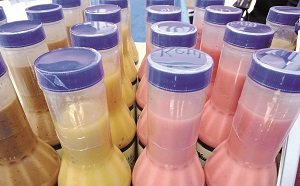As more Asian consumers live their lives on-the-go, spending more time in transit every day, they are increasingly consuming meals and snacks on the run. These ‘transumers’ value convenient food that is presented in preportioned and highly portable food packaging. But convenience is not the only thing driving the buying decisions of Asian transumers. They also want to lead sustainable lifestyles and this is putting brand owners under pressure to embrace sustainable practices and ensure their goods have minimum impact on the environment.
While packaging has undoubtedly played a critical role in enabling fresh and safe on-the-go products, it is still often seen as a significant generator of waste, which is harmful to the planet. Smart brands are adopting packaging that aligns sustainability with convenience to meet the expectations of today’s on-the-go shopper.
Attracting transumers with innovative packaging

Modern lives are increasing the demand for small, disposable and easily transportable packaging designs. For example, flexible packaging is now the second-most popular form of packaging amongst new products, while pouches and sachets have experienced the biggest growth in the market. It is also an area where new shapes and closures are combining to make some unique packaging.
Single-serve flexible pouches also offer an ideal solution for transumers as they are easy to transport and carry and can be eaten whenever the consumer wants in a packaging that’s small and lightweight. The emergence of the ‘shot format’ in nuts and dried fruit and smaller snap packs are also examples of how brands are innovating to address on-the-go needs, while also allowing consumers to experiment with a variety of flavours and product types.
A great example of portable packaging innovation for transumers is Baruvi Fresh’s hummustir, a uniquely appealing, shelf-stable hummus kit that allows consumers to safely transport the ingredients and combine them anywhere, at any time, to enjoy organic and preservative-free hummus. Kit components include a laminated retort pouch for the chickpea purée and two smaller foil packs containing toasted tahini and spices. The pouches, along with an included wooden stirrer, are held in a round, lidded paperboard cup.
Packaging for convenience and green living
While not a new stimulus, sustainability has certainly evolved as a key driver in Asia, and the rise of single use packaging and disposable containers for on-the-go consumption is becoming an increasing environmental concern. To combat this issue, companies must focus on providing highly recyclable packaging options and think about redesigning packaging that uses less materials.
 Advances in science and technology are fuelling the trend towards sustainable and convenient packaging. These developments are not only focused on using sustainable materials and processes to create the packaging, but also ensuring it is easy to recycle. For example, new barrier materials that coat disposable cups and plates, are now as effective and affordable as traditional plastic coatings but significantly more sustainable and easier to recycle.
Advances in science and technology are fuelling the trend towards sustainable and convenient packaging. These developments are not only focused on using sustainable materials and processes to create the packaging, but also ensuring it is easy to recycle. For example, new barrier materials that coat disposable cups and plates, are now as effective and affordable as traditional plastic coatings but significantly more sustainable and easier to recycle.
Paper-based packaging with a water-based coating offers a versatile and responsible solution for manufacturers, retailers and consumers. In addition, specialty fibers, including micro- and nano-fibers, are revolutionizing a wide range of materials by enhancing strength, thermal stability, flexibility and crack resistance, and providing efficient thickening.
One particularly promising specialty fiber is micro-fibrillated cellulose, a unique fiber extracted from plant waste such as carrots or sugar beets; so it’s a very efficient, highly sustainable, renewable material, used to strengthen and lighten fiber products sustainably.
Stand-up pouches are also emerging as a popular eco-friendly solution to enclose snacks and drinks. Compared to cans, boxes or rigid plastic containers, these pouches use less material, improve the product-to-package ratio and reduce over-packaging and waste.
There are also companies focused on innovative solutions that could be applied to on-the-go products. Florida-based Saltwater Brewery has developed edible sixpack rings to help tackle the problem of ocean plastic pollution, while others are making packaging materials from compostable corn starch or sorghum.
As concerns about sustainability continue to rise and influence consumers’ buying decisions, brand owners and packaging manufacturers need to focus on these and emerging eco-friendly solutions for their on-the-go products. Those that don’t risk losing to competitors that not only provide convenience, but also help people live less wastefully.










